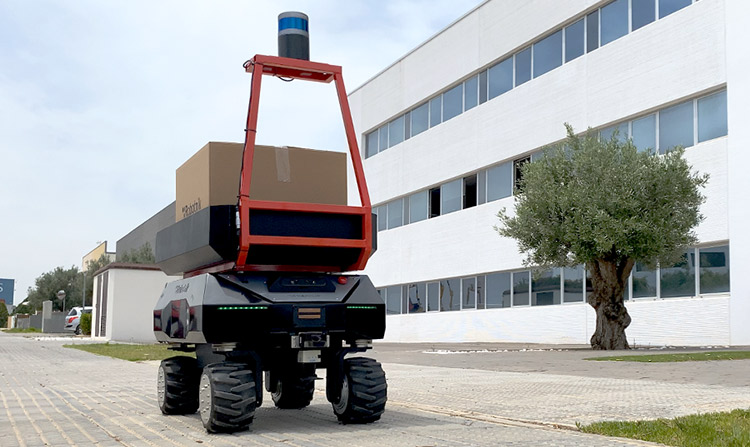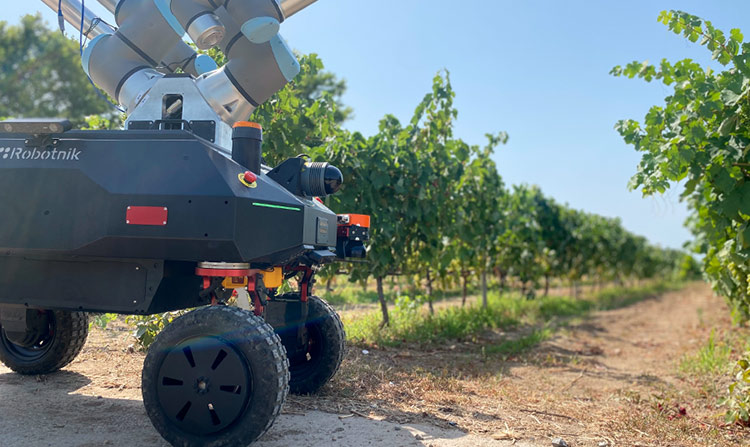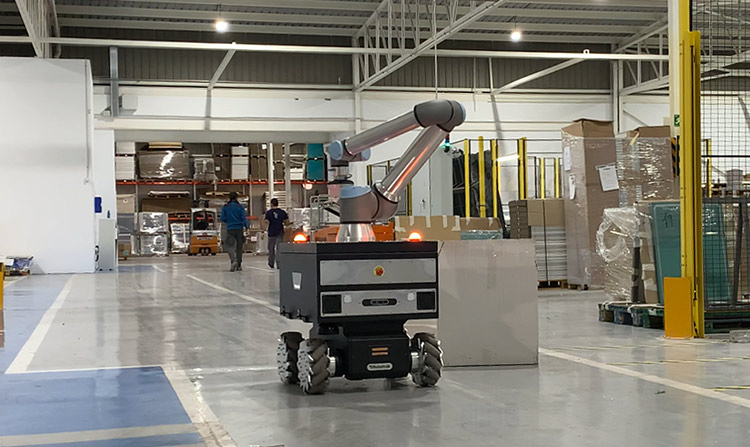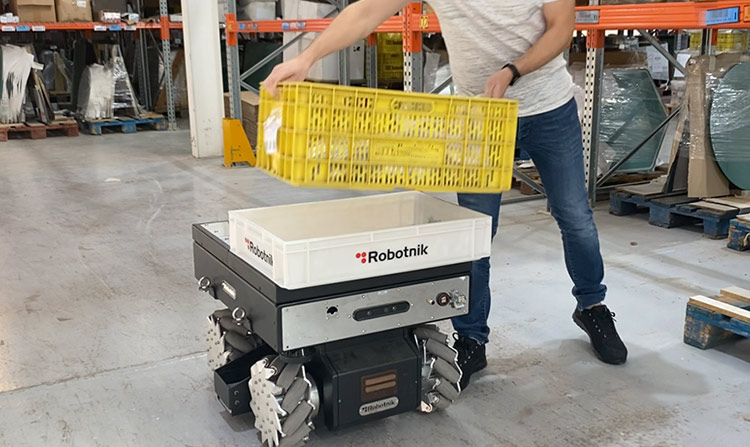- Robotnik is a leader in autonomous and collaborative mobile robotics. Here you can read some frequently asked questions about autonomous mobile robotics.
Collaborative mobile robotics is already a reality in many companies. According to the Fortune Business Insights report, ‘the global autonomous mobile robot (AMR) market size was $1.67 billion in 2020’. However, many of them, especially SMEs, still have multiple doubts about how this technology can help their companies. As a leading company in the industry, we receive numerous queries in this regard. The first phase of any industrial implementation is the analysis phase and, from this phase, a multitude of unknowns arise. In this article, Robotnik answers some of the most frequently asked questions about autonomous mobile robotics.
1. Difference between AGVs and AMR
AGVs (Automatic Guided Vehicles) have existed since the 1950s, normally for the transport of heavy loads. Their main characteristic is that they run on a lane or belt and follow a predetermined route. More advanced AGVs, on the other hand, are capable of detecting obstacles, but not of re-routing, so that when they encounter an obstacle, the robot will stop.
There are many differences and advantages of autonomous mobile robots (AMRs) over traditional AGVS (as can be seen in a previous article on Robotnik’s blog). One of the main differences is that AMRs use free navigation by means of lasers, while AGVs are located with fixed elements: magnetic tapes, magnets, beacons… This means that in warehouses and places where the work environment is shared with humans, AMRs work better due to their dynamism and efficiency to share tasks.
2. In which areas or sectors can collaborative mobile robotics be applied?
It is difficult to say in which sectors it can be applied because Robotnik’s experience shows that it is applicable to absolutely any sector.
Flexibility, collaboration between machines and people and diversification into new sectors and business models are setting the pace for robotics in 2021, according to the conclusions published by the International Federation of Robotics (IFR).
Particularly in Robotnik, we work with very diverse sectors: industrial, agri-food, health, defense or rescue, construction, logistics, academic…
In the end, the sector is autonomous mobile robotics, therefore, any area that needs to automate a task through this type of robots, is part of Robotnik’s target.
To be specific, it is true that the most demanded application by industrial customers is the transport of loads from one point to another or pick and place in the case of mobile manipulators. In addition, Robotnik’s robots have the capacity to combine the process in indoor and outdoor environments, one of the competitive advantages of the company and the reason why many customers choose it. Many companies require transport to be carried out both indoors and outdoors (e.g., when they have several buildings), so the most optimal solution is for the same vehicle to carry it out.
Other applications that are also common: picking tasks (in collaboration with an operator to speed up the order process), inspection applications (the robot can send an alert if it detects something out of place, normally thermography is used for this purpose) and surveillance or security (instead of the traditional fixed camera, the robot can travel around different points of a warehouse or factory, so it covers more points), selective spraying in agriculture, fruit inspection…
3. What exactly is an autonomous mobile robot?
There is a certain belief that an autonomous mobile robot (AMR) is simply a programmed machine and this is not the case. An autonomous robot must have the independence to make decisions in a work environment, without the need for human intervention.
There are many industrial machines that, when they perceive an obstacle, do not have the ability to decide, for example, to change their route. Therefore, these machines cannot be considered AMRs.
For a robot to be truly autonomous, it must perceive and understand the environment, making decisions that allow it to operate in the most effective way, even if the environment is changing.
4. What happens if the robot encounters an obstacle?
Robotnik integrates sensors and various components into its robots that receive, process and analyses data in real time and act accordingly. In other words, when an autonomous mobile robot encounters an obstacle on its route, such as a pallet, it will recalculate the route if possible or stop if it detects that it could harm the operators.
5. What are the phases of an industrial implementation project?
First of all, the application in which you want to use mobile robotics must be analysed. If it is viable, a technical and economic offer is drawn up. Then a pilot project is carried out, which is already part of the development of the project.
These projects require almost no maintenance, so that once the installation is optimised, the customer can manage it autonomously, thanks to the tools that Robotnik provides: Fleet Management System and User Interface.
6. How will automation affect my employees?
As we have said before, autonomy gives the robot the ability to know and recognise the environment in which it is working. This gives the operators more working capacity, as they do not have to be aware of the robot.
Therefore, this will be a first change for workers: to be able to focus on the tasks they perform without the need to supervise the robot and to free themselves from mechanical, heavy and even dangerous activities.
Undoubtedly, one of the questions that most concerns society is how robots will transform the workplace. A few months ago, Jeff Burnstein, president of the Association for Advancing Automation, said that the trend is for ‘better, safer, higher-paying jobs to be created by robotics, as technology increases what people do best, while doing the jobs people don’t want to do’.
Throughout history, as technology has advanced, thousands of processes have been automated in factories that have improved the quality of life for their workers, this need be no different in the case of collaborative robotics.
7. How do I train my employees to coexist with mobile robotics?
One of the main advantages of Robotnik’s AMRs is their easy configuration and installation thanks to their open software and hardware, which allows them to be adapted to the specific needs of the client and/or the application. In the end, this translates into quick and easy commissioning.
It may happen that in the staff of a factory or warehouse there are workers with a technical profile capable of leading the integration of robotics, but this is not usual. The service provided by the Engineering Department is one of the most appreciated aspects of Robotnik. A few months ago, Mr. Con Cronin of KOSTAL Ireland GmbH coined a review for us that spoke precisely of this: ‘Robotnik’s staff have always accompanied us in the process, going beyond their field of work. Robotnik engineers have developed a proof of concept and transformed it into a system ready for real production’.
8. What are the most disruptive technologies associated with robotics today?
Right now, you cannot understand robotics without talking about 5G, Artificial Intelligence or augmented reality. Another example of the most technologically innovative points: at Robotnik we not only work with 2D navigation but we are already using 3D.
9. How is AI used in robots?
Collaborative mobile robotics is evolving hand in hand with Artificial Intelligence. In the end, at Robotnik we develop autonomous mobile robots that will share space with humans and this implies that they have the ability to “think” for themselves in certain situations and make decisions that a human would make, but being a machine.
10. What does it mean for a robot to integrate ROS architecture?
In recent years, ROS has become a standard in Service Robotics, and great advances are being made in the industrial sector.
Most robots and components on the market are supported in ROS. Sometimes it is not easy to find out which ones are, which version they support or how to acquire them. It’s all about finding a way to help the development of robotic applications, facilitating the communication between sensors and algorithms. Following the paradigm of “program once, test everywhere”.
11. What are the most important components/sensors of a collaborative mobile robot?
Robotnik’s mobile robots have multiple integration possibilities like LiDAR devices, cameras, collaborative arms (for example, those of Universal Robots) or environmental sensors.
Of course, special mention should be made of safety lasers, the basis for collaborative autonomous localization and navigation.





